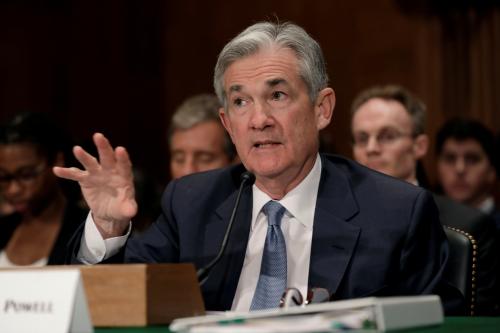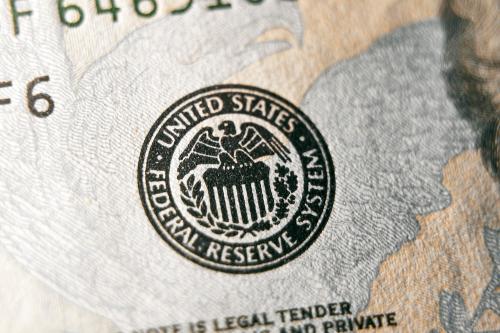This blog post is adapted from a monthly feature in the Brookings Cafeteria podcast called “Wessel’s Economic Update” where Senior Fellow David Wessel discusses recent developments and projections in the economy. The transcript may be slightly edited from the audio recording.
The unemployment rate—the percentage of Americans 16 and older who are looking for work and can’t find a job—is down to 3.7 percent. The last time it was this low was October 1969. Richard Nixon was president.
Economic forecasters, for what it’s worth, see the unemployment rate continuing to fall toward an extraordinarily low 3.4 percent over the next year. Other measures of the job market, like the one that counts people who have given up looking for work and part-time workers who’d prefer full time jobs, are also at historically low levels.
Which raises a question: Can the unemployment rate fall too low?
To many of us, this is a jarring question. The more people working and the fewer people struggling to find jobs the better. Right? Sure, it’s a hassle for employers who find fewer applicants for their openings, and some of them might actually have to pay more, offer more attractive benefits or better working conditions, or even offer some more on-the-job training to get the workers they need—but that seems like a good deal for the overall economy.
So who is worried about too little unemployment? Well, some folks at the Federal Reserve for starters—and not because they are hard-hearted, nasty people. The Fed’s mandate is to achieve stable prices (which the Fed defines as 2 percent inflation) and maximum sustainable employment. Simply put, the Fed and many economists believe, based on history, that when unemployment falls below some threshold, wages and prices go up.
Now for most of the past decade, inflation was so far below the Fed’s 2 percent target that the Fed didn’t worry about this and kept interest rates extraordinarily low. But lately, inflation has been creeping towards that 2 percent target—and wages are beginning to rise, too (finally).
Simply put, the Fed and many economists believe, based on history, that when unemployment falls below some threshold, wages and prices go up.
The standard Fed story goes something like this: If unemployment gets too low and wages rise too much and inflation goes well above our target, we’ll have to respond by raising interest rates a lot and risking a recession. In this story, we’re all better off if the Fed gently raises interest rates, thereby slowing hiring just enough that the unemployment rate doesn’t fall too low. In Fedspeak, this is known as “a soft landing” and the Fed traditionally has trouble pulling this off.
But the art of central banking is to draw the right lessons from history, to avoid fighting the last war again, and to carefully look for how today’s economy is like the past, as well as how it’s different.
One thing that is certainly different today: Wages have been very, very slow to respond to falling unemployment rates. In part, that’s because the strong job market has drawn many workers off the sidelines—workers who weren’t counted as unemployed a couple of years ago because they weren’t looking for work. In part, that’s because globalization, technology, outsourcing, the gig economy, and the atrophying of unions have weakened the bargaining power of workers versus employers, so employers don’t have to raise wages like they once did. That recent history has led economists at the Fed, the Congressional Budget Office and elsewhere to move down their estimates of how low unemployment can go before it generates unwelcome inflation.
Twenty years ago, economists anticipated that wages would pick up if unemployment fell below 5 percent. Today’s consensus estimates of what’s known as the natural rate of unemployment—or NAIRU for “non-accelerating inflation rate of unemployment—are around 4.5 percent, which is, of course substantially above today’s 3.7 percent. The problem is that estimating the natural rate of unemployment is hard, particularly in real time. Which means it’s really hard to know how low unemployment can safely fall.
So the conversation at the Fed these days goes something like this: Most policymakers seem to agree that raising interest rates in December is wise. After all, interest rates remain very low given the strength of the economy. But there’s some disagreement about how fast the Fed should raise them next year.
One camp says that with unemployment headed below 3.5 percent, an unwelcome increase in inflation is inevitable and the Fed needs to be tough and do its job, not matter how unpopular. They need to slow hiring with several rate increases next year. After all, they say, the Fed already has allowed unemployment to drop below its best estimates of the natural rate.
The other camp, call it the wait-n-see camp, wants to be very cautious and move rates up very gently until wages and prices really respond to low unemployment and the vigor of the economy—especially since there are worrisome signs that global economic growth is slowing.
This is a judgment call, and ultimately it boils down to what risk the Fed is willing to take. Does it fear inflation so much that it’s willing to raise interest rates a lot, even if that risks prematurely curtailing hiring and wage increases? Or does it fear unemployment and hurting workers so much that it’s willing to risk inflation rising significantly above its target by holding off on rate increases? That’s the Fed’s big challenge for 2019.






Commentary
Wessel’s Economic Update: Can the unemployment rate fall too low?
November 16, 2018